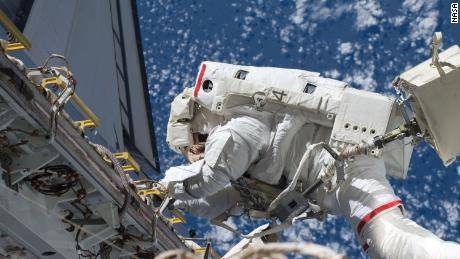(CNN) The International Space Station was due to get a powerful upgrade on Wednesday, but "technical delays" during a spacewalk left the astronauts without enough time to install a new set of solar arrays, according to NASA.
During the nearly seven-hour spacewalk, NASA astronaut Shane Kimbrough and European Space Agency astronaut Thomas Pesquet were slated to install the first two out of six ISS Roll-Out Solar Arrays , called iROSAs, which will upgrade six of the eight power channels on the space station.
But the astronauts encountered several issues. About three hours into the spacewalk, Kimbrough lost data on his spacesuit's display unit and was required to go back to the space station's airlock to reboot the system and get it back in working order. Then there was a momentary spike in the pressure reading on Kimbrough's spacesuit, which was stabilized shortly after but cost the astronauts precious time.
Then, after the astronauts moved the solar arrays to a mounting bracket, one panel was not aligning on the bracket when unfolded, according to Gary Jordan, a NASA public affairs officer. The spacewalkers took pictures for evaluation by ground teams and ran out of time to complete the last steps — installing electrical cables and the final two bolts that would allow the solar arrays to unfurl.
The astronauts were then instructed to fold the array back up and "bolt it in place in a safe configuration," where it will remain for the time being, said Rob Navias, a NASA public affairs officer, during a webcast of the spacewalk.
Read More
var id = '//platform.twitter.com/widgets.js'.replace(/\s+/g, '');!!document.getElementById(id) || (function makeEmbedScript(d, id) {var js,fjs;js = d.createElement('script');js.id = id;js.charset = 'utf-8';js.setAttribute('async', '');js.src = '//platform.twitter.com/widgets.js';fjs = d.getElementsByTagName('script')[0];fjs.parentNode.insertBefore(js, fjs);}(document, id)); Update: Due to technical delays earlier in the day, the spacewalkers will not have enough time to fully install the first pair of new, roll-up solar arrays on the @Space_Station . Stay tuned for more info! pic.twitter.com/fBiUNvfQGL — NASA (@NASA) June 16, 2021 While the current solar arrays on the space station are still functioning, they have been supplying power to the space station for more than 20 years and are showing some signs of wear after long-term exposure to the space environment. The arrays were originally designed to last 15 years. The two astronauts were scheduled to continue the iROSA upgrades during a spacewalk on Sunday. The ISS mission managers and engineers will hold "discussions over the next day or so as to what the next course of action will be," Navias said. This is what it's like to walk in space The new iROSA arrays arrived at the space station on June 5 after launching on the 22nd SpaceX Dragon cargo resupply mission. The space station's robotic Canadarm2 was used to remove the solar arrays from the spacecraft last Thursday. The arrays were rolled up like carpet and are 750 pounds (340 kilograms) and 10 feet (3 meters) wide. Unfurled, the arrays are expected to be about 63 feet (19 meters) long and 20 feet (6 meters) wide. The solar arrays on the space station are due for an upgrade. {"@context": "http://schema.org","@type": "ImageObject","name": "The solar arrays on the space station are due for an upgrade.","description": "The solar arrays on the space station are due for an upgrade.","url": "//cdn.cnn.com/cnnnext/dam/assets/210615101220-02-iss-solar-arrays-spacewalk-large-169.jpg"} To protect the astronauts as they worked around electrical connectors, the ground crew conducted a plasma forecast to determine what kind of electrical charge the space station would be in during the walk, according to Kieth Johnson, spacewalk officer. Metallic aspects of the astronauts' spacesuits were also covered to prevent metal contact that could cause electric shock. The time of the spacewalk was planned so the giant solar arrays would be in darkness and not generating power. Astronaut Shane Kimbrough is seen here during a 2008 spacewalk. {"@context": "http://schema.org","@type": "ImageObject","name": "Astronaut Shane Kimbrough is seen here during a 2008 spacewalk.","description": "Astronaut Shane Kimbrough is seen here during a 2008 spacewalk.","url": "//cdn.cnn.com/cnnnext/dam/assets/210615101150-01-iss-solar-arrays-spacewalk-large-169.jpg"} Wednesday's spacewalk was not the first time Kimbrough and Pesquet have taken a walk outside the space station together. They were on the space station in 2017 and previously conducted two spacewalks together to replace aging nickel-hydrogen batteries with new, longer-lasting lithium-ion batteries. NASA designs new spacesuits for next lunar mission in 2024 The new solar arrays are slated to be placed in front of the old ones. This will increase the space station's total available power from 160 kilowatts to 215 kilowatts. It's also a good test for the new solar arrays because this same design will power parts of the Gateway lunar outpost, which will help humans return to the moon through NASA's Artemis program in 2024 . "The exposed portion of the old arrays will still be generating power in parallel with the new arrays, but those new Iris arrays have solar cells on them that are more efficient than our original cells," said Dana Weigel, deputy manager of the International Space Station Program. "They have a higher energy density and together in combination may generate more power than what our original array, when it was new, did on its own." The new arrays will have a similar 15-year expected life span. However, since the degradation on the original arrays was expected to be worse, the team will monitor the new arrays to test their true longevity.

